The Perosio from Uruguay
Giovanni and Pasquala Perosio and your fathers decided to be resided in Paysandú, riverside city in the oriental coast of the river Uruguay that separates Argentina of the Oriental Republic of the Uruguay.
Paysandú at the moment is a very important city of Uruguay, it is located to 380 Km. from Montevideo. It is a border city located few kilometers from Colon (Argentina), the frontier is crossed by the imposing international “Gral. Artigas” bridge.
From 1749 begins the “Ypauzando” or Step of Sandú, signal with this name to the place on the river to pass the livestock and where you began to form the original town.
The creation in 1805 of the Parish of Paysandú with the I title of San Benito of Palermo it meant a recognition of the town of Paysandú. Their origins, with stable population, go back at 1752, When, soon after the war guaranítica they began to Live in the fork of the rivers Queguay and Uruguay, Indians of the town of San Borjas.
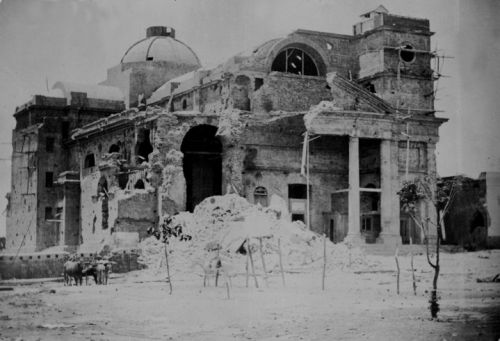
Church Nuestra Señora del Rosario and San Benito of Palermo after the bombardment in 1865.
Toward 1756, the authorities of the stay Yapeyú, established a position in the old step to which was denominated as the Indians they called to the island (today Caridad), Y-PAUCANDO: island interpolated amid the river. Later derivations, concluded in the current name: Paysandú. It recognizes it to him as the Heroic one to defend it their residents, until death, in 1811, 1846 and 1864.
To little of their arrival adverse events wrap there Juan and Pascuala Perosio... Events were gestating that would end in a fight among countries siblings in the denominated War of the Alliance Triple or War of the Paraguay.
Argentina, Brazil and Uruguay facing Paraguay, war that concludes in the year 1870..
The Uruguayan general Venancio Flores, supported by the Empire of Brazil of Pedro II and for the unitary of the Argentinean president Bartolomé Mitre, he gave a coup in the Oriental Republic, against the Uruguayan president Bernardo Prudencio Berros. The Gral. Flores committed to pay the received military and financial help of the two neighboring governments collaborating in turn in the destruction of Solano López's independent Paraguay... But first he had to assure their power.
With armament and European credits and with the support of the Brazilian imperial squad it was prepared of weapons in Buenos Aires, Venancio Flores advanced on Paysandú, the only city where she resisted the infamy. The Brazilian army crossed the frontier in the winter of 1864 and she left against the city of Paysandú, defended by the general Leandro Gómez with a handful of men; the Brazilian squad, after being supplied of bombs by President Mitre in Buenos Aires, overcame the river Uruguay and she went to Paysandú.
The Brazilian squad sieged and it bombarded the city with its canyons between the 6 and December 9, should be evacuated of her women, children and old men. The other inhabitants of Paysandú had taken refuge in the island, they lived under stores and small ranches, wretchedly built of rushes. The square was sieged by 2000 men of Flowers, 3000 infants, 1000 chivalry men and 48 pieces of Brazilian artillery. The military endowment of Paysandú suffered enormous low; but it resisted the blockade, refusing absolutely to the rendition proposed by the attackers.
In January 2, 1865 in spite of the heroic resistance, the attackers entered to the assault of the city, still defended by about 650 soldiers and loyal officials, to the control of the Gral. Leandro Gómez. The combat was fleshed, being finally defeated the defenders. Leandro Gómez was shot that same day. The residents after these bloody facts began to work to be reconstructed of their ashes, among them our ancestors...
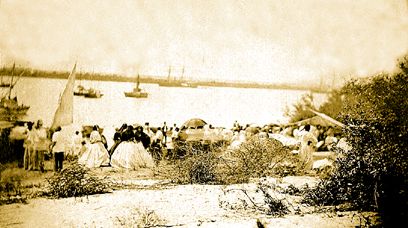
Partida de las familias sitiadas en la isla que está frente a Paysandú, que pasaría a llamarse “De la Caridad”.
The Brazilian squad sieged and it bombarded the city with its canyons between the 6 and December 9, should be evacuated of her women, children and old men. The other inhabitants of Paysandú had taken refuge in the island, they lived under stores and small ranches, wretchedly built of rushes. The square was sieged by 2000 men of Flowers, 3000 infants, 1000 chivalry men and 48 pieces of Brazilian artillery. The military endowment of Paysandú suffered enormous low; but it resisted the blockade, refusing absolutely to the rendition proposed by the attackers.
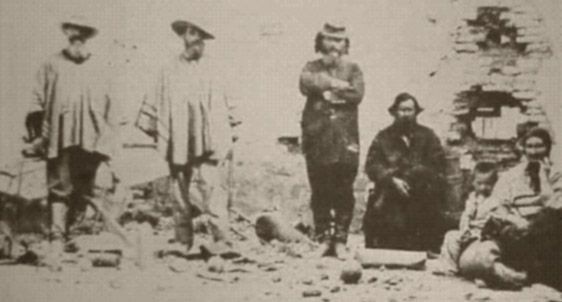
Leandro Gomez (on the extreme left) in the city of Paysandu where White forces under his command tried to resist to Brazilian troops under command of vice-Admiral Baron of Tamandare. January, 1865. Paysandu.
In January 2, 1865 in spite of the heroic resistance, the attackers entered to the assault of the city, still defended by about 650 soldiers and loyal officials, to the control of the Gral. Leandro Gómez. The combat was fleshed, being finally defeated the defenders. Leandro Gómez was shot that same day. The residents after these bloody facts began to work to be reconstructed of their ashes, among them our ancestors....
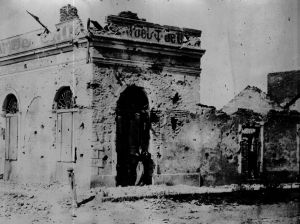
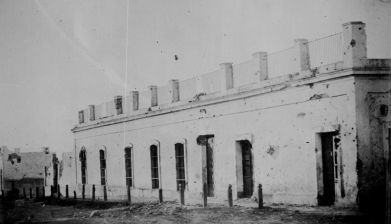
Luigi Perosio (1804-1868) farmer , natural of the province of Genoa and ancestor of the first Perosio they arrived to the “Río de La Plata” passes away in Paysandú little time later dies in March 3, 1868 and its wife Anna Parodi survives him, she dies in July 18, 1879 to the 65 year-old age.
Their remains rest in Paysandú, in the Italian cemetery.
-
Giovanni (Juan) Perosio Parodi was born August 9 1837 in Sarisolla, Busalla, baptized August 10 1837 in the church San Giorgio of Sarissola.
Married with Rosa Maddalena Semino Perosio (1848-1926) on 22 of September of 1867, in the church San Benito of Palermo.en Paysandú Uruguay. Rosa was natural of Sarissola, daughter of Giovanni Battista Semino and Pasquala Perosio.They had six children.
For testimonies picked up by family tradition and carried out investigations, we deduce that most of their lives was developed in Paysandú except periods where Giovanni Perosio and Rosa Semino, reside transitorily in Colon, county of Entre Ríos, Argentina, where their son Juan Nicolás is born in 1875 in Concepción del Uruguay, county of Entre Ríos, Argentina, where Ángel Juan is born in 1878.
Giovanni (Juan) Perosio Parodi was owner of the factory of noodles and proprietor of a floury mill. See Notables.
The already mentioned Luis born in 1868, Anita born in 1870, Pascuala born in 1873 and Rosa in 1879 is born in Paysandú.
- Luis Perosio Semino (1868-1893) married with Seferina Venturino Scarone with the one who have a daughter:
- Juana Luisa Perosio Venturino,born the 6-28-1890.
Luis dies later in Paysandú three years to the 25 year-old age, the 12-9-1893.
- Luis Perosio Semino (1868-1893) married with Seferina Venturino Scarone with the one who have a daughter:
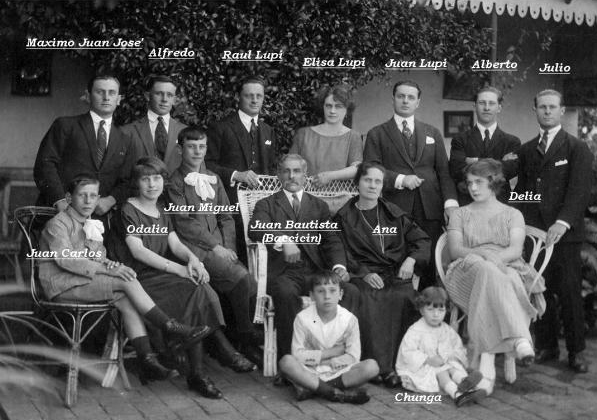
Family Salvarezza Perosio Luppi .
- Anita Perosio Semino (1870-1950) she espouses twice in the first place with Emilio Luppi Ducco, proprietor of a floury mill ,with who has four children :
- Teresa Francisca Luppi Perosio ( 1890-1969) m.w Felix Policarpo Attales Delthey.
- Emilio Julio Luppi Perosio (1894-1898).
- Raúl Antonio Luppi Perosio (1894-1966) m.w Marcela Broucas.
- Juan Bautista Luppi Perosio m.w Delia Barussi.
- Miguel Angel Salvarezza Perosio
- Máximo Juan José Salvarezza Perosio m.w Elena Russo
- Alberto Casimiro Salvarezza Perosio m.w Ana Degregori
- Julio Enrique Salvarezza Perosio m.w Juana Barbisan
- Alfredo Gumersindo Salvarezza Perosio m.w Esther Goñi
- María Odalia Salvarezza Perosio m.w J.Tramontín
- Juan Miguel Salvarezza Perosio m.w María Imperatrice (1910-2005)
- Osvaldo Martín Salvarezza Perosio m.w Lucrecia Arrigo
- Juan Francisco Salvarezza Perosio (1909-2006) m.w Emilia Joray y Esperanza Catalina Martinez
Died Emilio Luppi Ducco in an accident in Casa Blanca near town to Paysandú married with ( January 5 1899) Gian Battista Salvarezza, maker of liquors of Busalla,Genova with which you resides in the city “Concepción del Uruguay” , county of Entre Ríos Argentina and they have 9 children:
- Pascuala Perosio Semino born in April 23, 1873 married in first wedlock in 1898 Angel Zuccarino with the one who they have a called son:
- Juan Pascual Zuccarino Perosio.
- Alberto Mauricio Siri Perosio.
- Claudio Mauricio Siri Perosio.
The second wedlock (28-9-1905) was with Mauricio Siri Pesce (1851-X), they have two children:
- Juan Nicolas Perosio Semino (1875-1903) married with Celestina Mariana Nacini, two children:
- Juan Julian Perosio Nacini (1900-1988) married with Rosa Angelica Gonzalez and in a second wedlock with Odalina Mendoza Amaral.
- Maria Elisa Perosio Nacini (1902-1982), married with Santiago Cranchi (1894-1948).
- Ángel Juan Perosio Semino, born in 1878, surprisingly also dies the July 1, 1903, to the 25 years and are single.
- Rosa Perosio Semino, born in Paysandú the 4-9-1879, married with Francisco Leunda (1881-1932).
- Pascuala Perosio Parodi, nacida en 1844 al igual que sus hermanos en Sarissola, Génova, se desposa con José Barchi, con quien tienen una única hija Rosa Eleonora Barchi Perosio nacida el 11 de abril de 1881. Fallece el 7de febrero de 1899 en Paysandú. (Registro Civil).
The Perosio and their descendants still reside in this country brother from Argentina...
Source:
Parochial files of Paysandú and Uruguayan Civil Registration (x) .
(X) Center of Family History of The Church of the Saints of last days .
Developed by